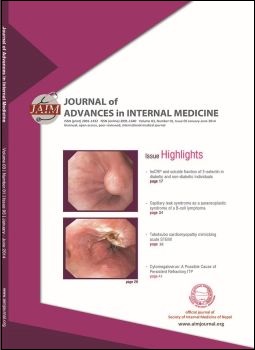Association of hsCRP and soluble fraction of E-selectin with diabetic and non-diabetic individuals
DOI:
https://doi.org/10.3126/jaim.v3i1.10697Keywords:
Endothelial dysfunction, high sensitive C-reactive protein, soluble E-selectin, Inflammatory markerAbstract
doiBackground and aims: It is known that endothelial dysfunction and low-grade inflammation are important element of diabetic complications. The soluble E-selectin is a marker of endothelial dysfunction and C-reactive protein is the most important inflammatory marker. The present study is done to investigate the effect of diabetes on these two markers.
Methods: The present hospital based case control study was conducted in the department of Biochemistry with the collaboration of department of Medicine of Burdwan Medical College, Burdwan, west Bengal India. All subjects were selected by simple random sampling between March 2011 and May 2013. Blood level of these soluble E-selectin and high sensitive C-reactive protein were measured in two hundred diabetic and two hundred age, sex and other non-modifiable as well as modifiable risk factors matched non-diabetic healthy controls.
Results: Compared with control value of high sensitive C-reactive protein and soluble E-selectin levels were higher in diabetic subjects (p < 0.001). Our present study shows that levels of adhesion molecules and high sensitive C-reactive protein were higher in diabetic than non-diabetic.
Conclusion: These data suggested that an increased level of inflammatory markers and adhesion molecules among diabetic compared with non-diabetic subjects. This suggests that chronic uncontrolled hyperglycemia contributes to progression of atherosclerosis associated with life-threading complications in middle-aged diabetic patients.
DOI: http://dx.doi.org/10.3126/jaim.v3i1.10697
Journal of Advances in Internal Medicine 2014;03(01):17-22
Downloads
Downloads
Published
How to Cite
Issue
Section
License
This license enables reusers to distribute, remix, adapt, and build upon the material in any medium or format, so long as attribution is given to the creator.




